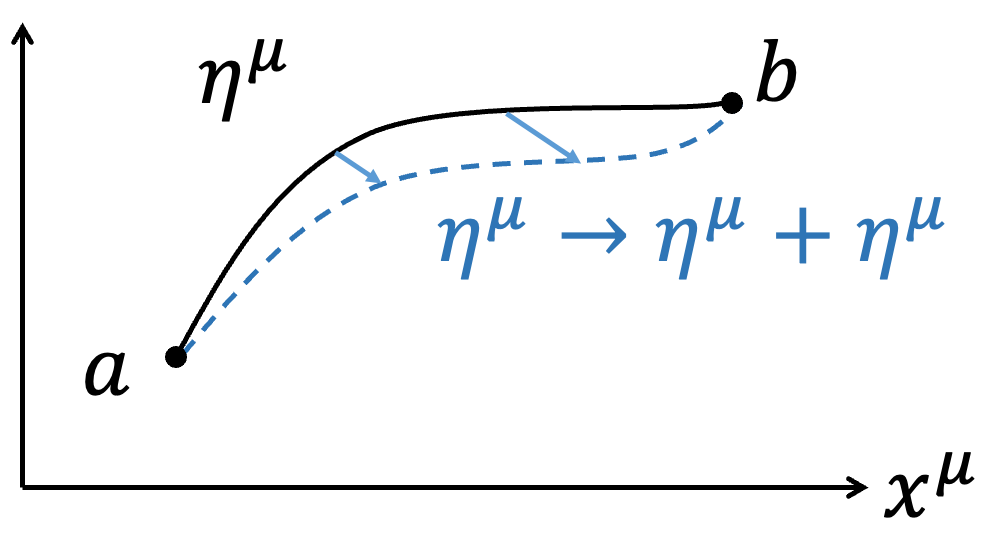Variation of Free Particle Action
In the relativistic case, to describe a free particle, we use the 4-displacement
$$\eta =\eta ^\mu \hat{e} _\mu =(\tau ,\overrightarrow{0} )_{porper}=(t,\overrightarrow{\eta})$$
to describe the trajectory of the particle, where \(\tau\) is the particle's proper time. Here, \(\eta ^\mu\) is used to distinguish the trajectory from spacetime (to accommodate subsequent discussions on Noether's theorem, it is necessary to rigorously distinguish between the trajectory and spacetime; the trajectory is a physical quantity, while spacetime is a coordinate system, which are different concepts). To describe the particle's velocity, we use the 4-Velocity \(U=U^\mu \hat{e} _\mu =(\gamma c,\gamma \overrightarrow{v} )={d\eta ^\mu \over d\tau} \hat{e} _\mu\), where \(\tau\) is the particle's proper time. Furthermore, \(U^\mu =U^\mu (x^\nu )\), meaning that the velocity \(U^\mu\) changes with different coordinates \(x^\nu\) in spacetime. The idea here is that a free particle moves from point a to point b in spacetime, and we calculate the extremum of the Action \(S_P\) for different paths \(\eta ^\mu\) by varying \(x^\mu\):
 $$\eta ^\mu \to \eta ^\mu +\delta \eta ^\mu $$
$$\delta \eta ^\mu (a)=\delta \eta ^\mu (b)=0$$
The Action \(S_P\) for a free particle is:
$$S_P=\int _a^b -mc^2 d\tau $$
After variation:
$$\delta S_P=\delta \int _a^b -mc^2 d\tau =-mc^2 \int _a^b \delta d\tau $$
It may seem that \(d\tau \) is unrelated to the variation \(\eta ^\mu \to \eta ^\mu +\delta \eta ^\mu\), but recall:
$$∵c^2 d\tau ^2=d\eta ^\mu d\eta _\mu $$
$$∴cd\tau =\sqrt{d\eta ^\mu d\eta _\mu}$$
Thus:
$$\delta S_P=-mc\int _a^b \delta \sqrt{d\eta ^\mu d\eta _\mu}$$
$$=-mc\int _a^b {1\over 2} {\color{red}{\delta d\eta ^\mu \cdot d\eta _\mu +d\eta ^\mu \cdot \delta d\eta _\mu} \over \sqrt{d\eta ^\mu d\eta _\mu}} $$
$$\eta ^\mu \to \eta ^\mu +\delta \eta ^\mu $$
$$\delta \eta ^\mu (a)=\delta \eta ^\mu (b)=0$$
The Action \(S_P\) for a free particle is:
$$S_P=\int _a^b -mc^2 d\tau $$
After variation:
$$\delta S_P=\delta \int _a^b -mc^2 d\tau =-mc^2 \int _a^b \delta d\tau $$
It may seem that \(d\tau \) is unrelated to the variation \(\eta ^\mu \to \eta ^\mu +\delta \eta ^\mu\), but recall:
$$∵c^2 d\tau ^2=d\eta ^\mu d\eta _\mu $$
$$∴cd\tau =\sqrt{d\eta ^\mu d\eta _\mu}$$
Thus:
$$\delta S_P=-mc\int _a^b \delta \sqrt{d\eta ^\mu d\eta _\mu}$$
$$=-mc\int _a^b {1\over 2} {\color{red}{\delta d\eta ^\mu \cdot d\eta _\mu +d\eta ^\mu \cdot \delta d\eta _\mu} \over \sqrt{d\eta ^\mu d\eta _\mu}} $$
|
Advanced: Thm.4: |
$$\delta S_P=-mc\int _a^b {1\over 2} {2\delta d\eta ^\mu\cdot d\eta _\mu \over \sqrt{d\eta ^\mu d\eta _\mu}} $$ $$= -mc\int _a^b {\delta d\eta ^\mu \cdot d\eta _\mu \over cd\tau}$$ $$ =-m\int _a^b \delta d\eta ^\mu \cdot U_\mu $$ Using the method of Thm.1, we exchange \(\delta dx^\mu \) with \(d\delta x^\mu\), and perform integration by parts: $$\delta S_P=-m\int _a^b U_\mu d\delta \eta ^\mu $$ $$=\color{red}{ -\left[ U_\mu \delta \eta ^\mu \right]\Big| _a^b}+m\int _a^b dU_\mu \delta \eta ^\mu$$ The boundary term is zero because the boundary variation \(\delta \eta ^\mu (a)=\delta \eta ^\mu (b)=0\). The latter term can be multiplied and divided by \(d\tau\) without affecting the variation, according to Thm.3: $$\delta S_P=m\int _a^b dU_\mu \delta \eta ^\mu $$ $$ =\int _a^b {m (dU_\mu )\over d\tau} \delta \eta ^\mu d\tau $$ So, for a free particle, \(\delta S_P=0\) leads to: \(m {dU_\mu \over d\tau} =0\) Considering \(\mu =1\sim 3\): $$m {d\overrightarrow{v}\over d\tau} =0$$ A free particle has no acceleration and maintains uniform motion.
Originally written in Chinese by the author, these articles are translated into English to invite cross-language resonance.
 Peir-Ru Wang
Peir-Ru Wang